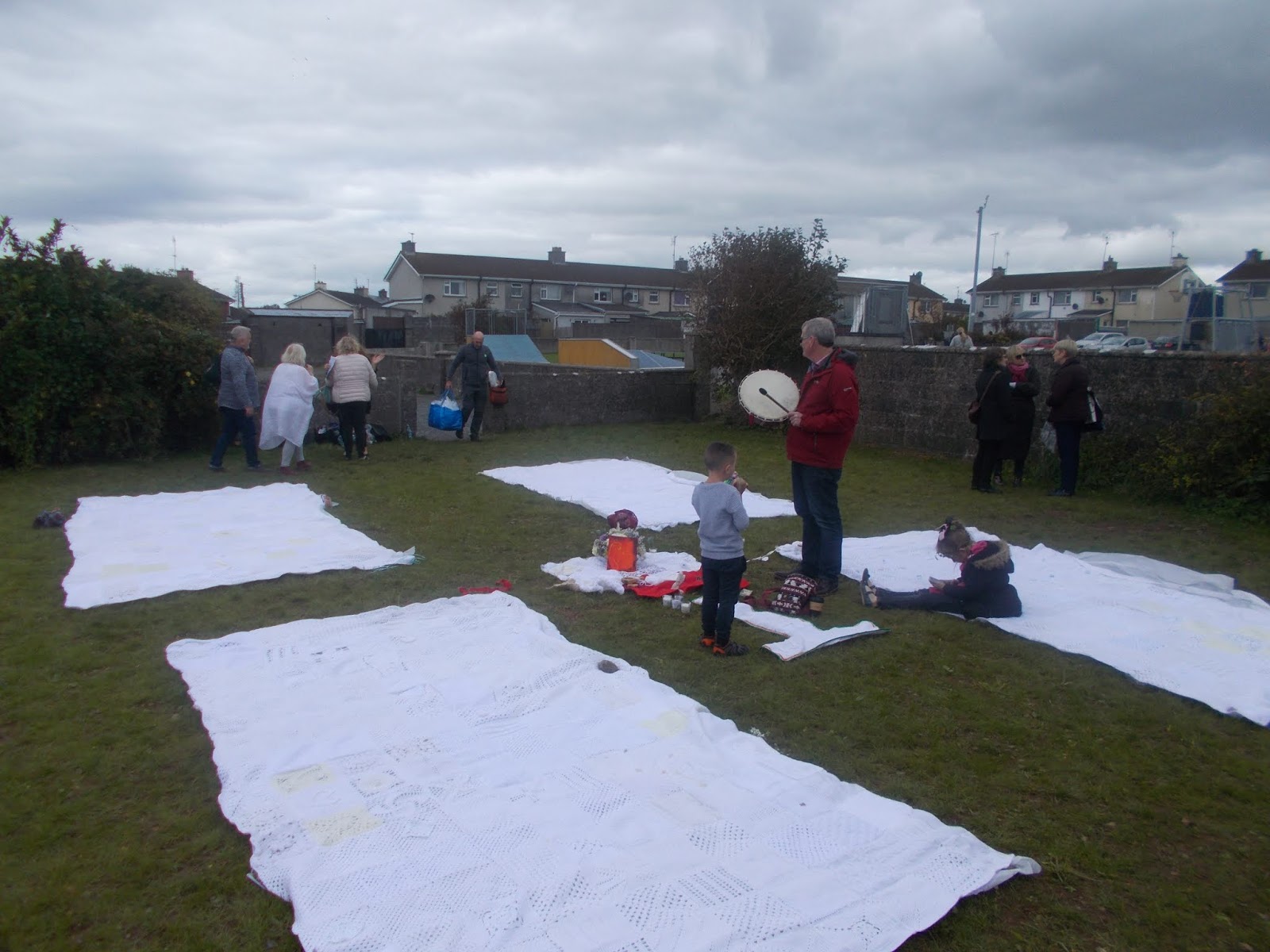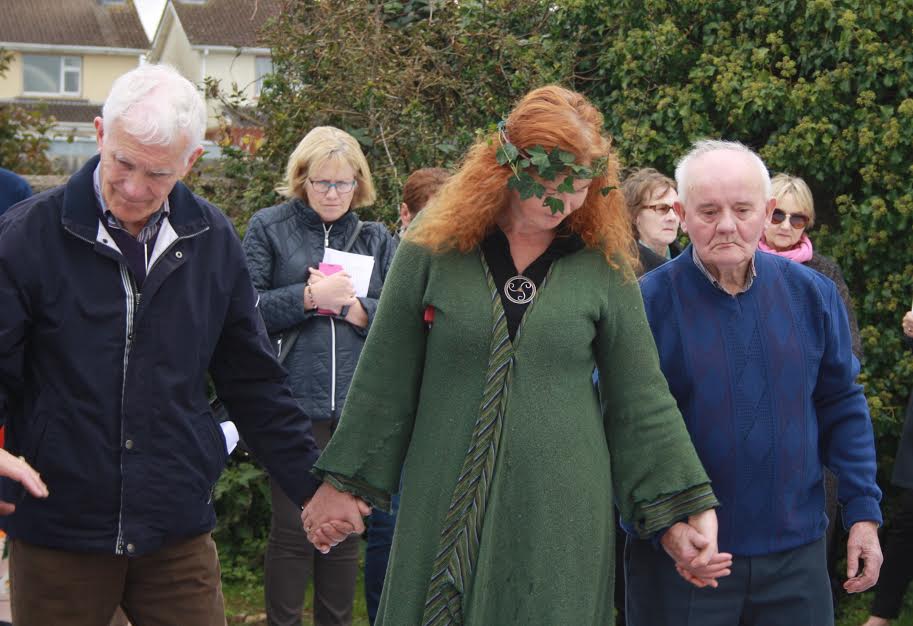
The beautiful white blanket featuring 796 squares for each of the babies
Three hundred women all across the globe, including many in North America, were inspired by a Dublin artist to make a blanket of 796 hand-knitted pieces which they presented to the families and survivors of the Tuam Mother and Baby Home on Saturday.
In an emotional ceremony at the site where up to 796 babies and children are believed to have been buried in an unmarked grave, Dublin artist Barbara O’Meara unveiled the beautiful white blanket – sewn together in four parts to depict the four provinces of Ireland – to the family members after meeting them for the first time.
The unveiling of the beautiful blanket, knitted by hand following a Facebook campaign, coincided with an inaugural Remembrance Day for the Lost Children of Ireland event at the site of the former home.
Former residents of institutions across Ireland travelled to Tuam for the event, which included poetry from survivors, a concert, and the screening of a documentary about the ‘Tuam Babies’ which is due to be shown in New York and Boston at the end of this month.
The survivors are still trying to reach out to people in North America who may have been adopted illegally from Catholic institutions in Ireland, as they have no idea how many of the children really are buried next to a playground in the Co Galway town.
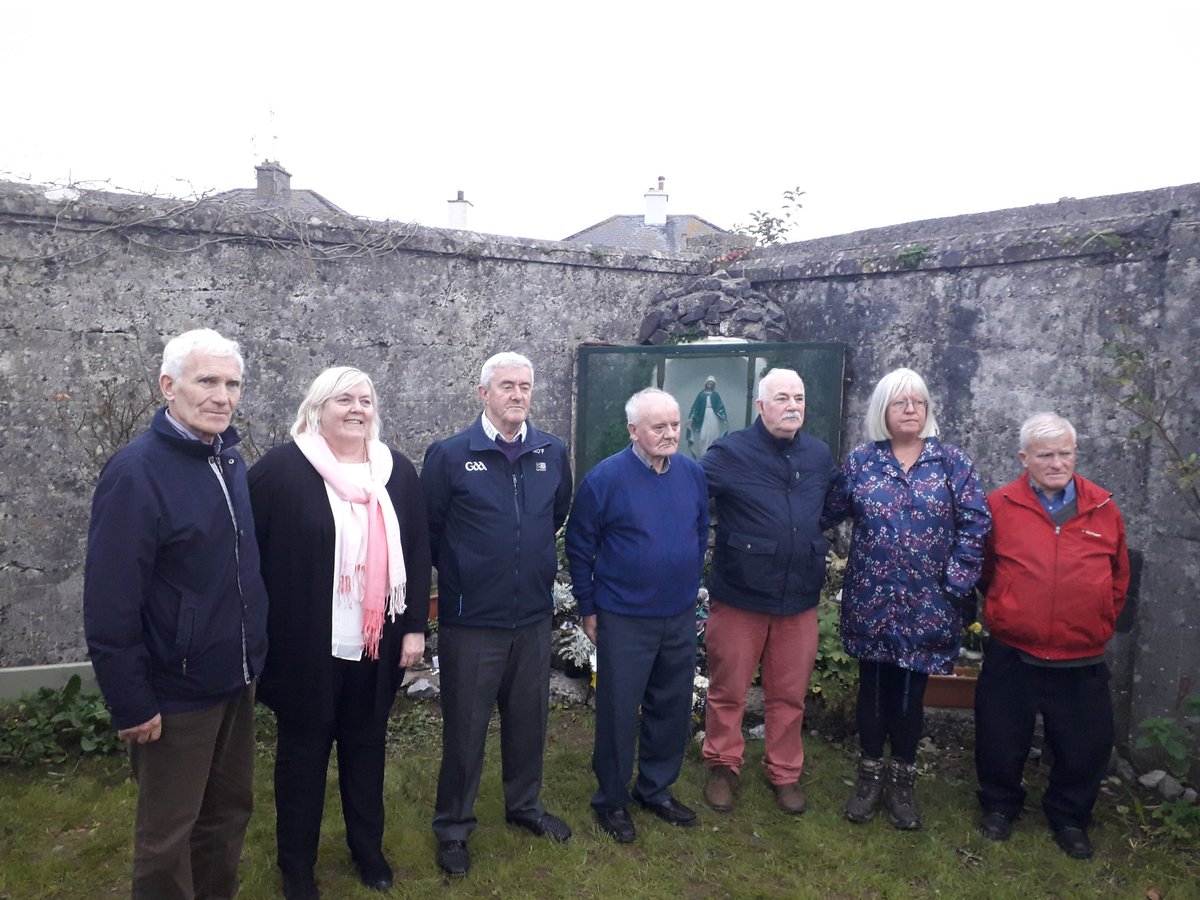
Survivors and family members at the Tuam site
Tuam Home Survivors Network Chairman Peter Mulryan, whose younger sister is one of the 796 dead babies, said the survivors continue to be overwhelmed by the support they receive from across the globe.
Now 74, Peter only found out he had a younger sister among the ‘Tuam Babies’ four years ago. He has been on a mission to find out what happened to her ever since, and believes she may have been adopted by a family in the United States.
Until an exhumation is carried out at the site, he said he had no way of knowing what happened to her.
“We are the kind of people who would not have been known or heard of, but now we are being extremely well represented all over the world. It’s just mind-boggling, the way the wheel has turned around. We were classed as nobodies, people who were not to be heard,” said Mr Mulryan.
Mr Mulyran expressed anger that An Taoiseach, Leo Varadkar, had visited the site in a personal capacity after attending a Fine Gael party event in Galway recently, without making any attempt to contact the survivors.
He accused the Irish Government of trying to turn local residents against the survivors in determining the future of the site.
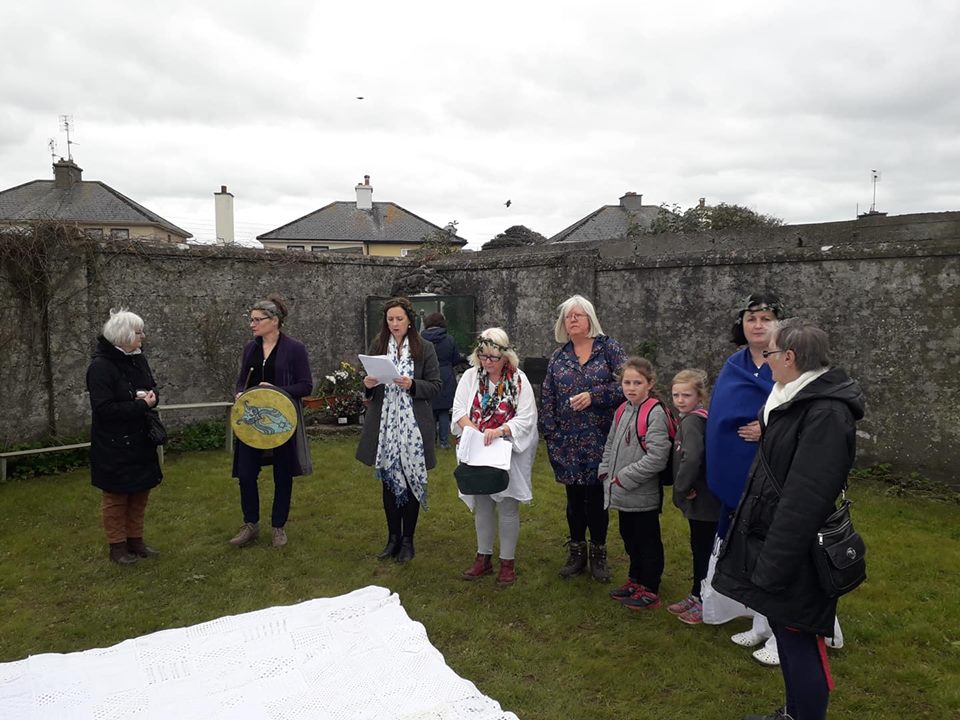 Reading out the names of the 796 'Tuam Babies'
Reading out the names of the 796 'Tuam Babies'
“Our search for justice is awful slow. We don’t understand why a public figure like An Taoiseach would come sneaking down, with nobody to meet him. It hurt us very much. We were so disgusted with An Taoiseach, to hear that he spoke to the residents, to ask them what they would like done here, rather than to ask us, the families and survivors,” he said.
Peter and his wife Kathleen are set to travel to the US in two weeks as a bid to reach out to people who were adopted from institutions in Ireland.
“We are hoping to meet up with people who believe they may have been adopted from Ireland. If anybody wants to contact we are here to help them,” he told me.
Although she has no connection with the Tuam families or the site, artist Barbara O’Meara said she was compelled to set up the ‘Stitched With Love’ project after watching coverage of the ‘Tuam Babies’ case on Irish television.
“I do a lot of work with marginalised groups, people with addiction or people who have been bereaved. I felt a need to do this project. I kind of realised that women wanted to do something to support the Tuam Babies and the survivors,” she said.
“I just set up a Facebook page and then women across the globe began to hear about it. Women from America, Scotland, and Australia began to get in touch. Everybody bought their own wool and I did have some help stitching them together. We got the 796 together and the survivors’ groups were informed. The project has taken two years, just me and a Facebook page!”
She said that women across the globe found a great sense of healing by knitting the 796 white squares and it was a really emotional experience to see the full blanket being unveiled at the site at the weekend.
She organised a Shamanic healing ceremony with Karen Ward, who had worked on her for a project to heal the children of the 1916 Easter Rising. Two bus-loads of women travelled from Dublin for the Tuam event and they were deeply moved by the experience.
“I hadn’t been to the site before and I decided not to come until the blankets came with me. I kept wondering how I would feel if my brother, my sister, or my mother was here. Having the sensibility of an artist, I am not very political or verbal. But I’m a creative person. When I walked onto the site I felt the energy was very heavy. It’s just an honour, really, to meet these survivors and honour these little children,” she said.
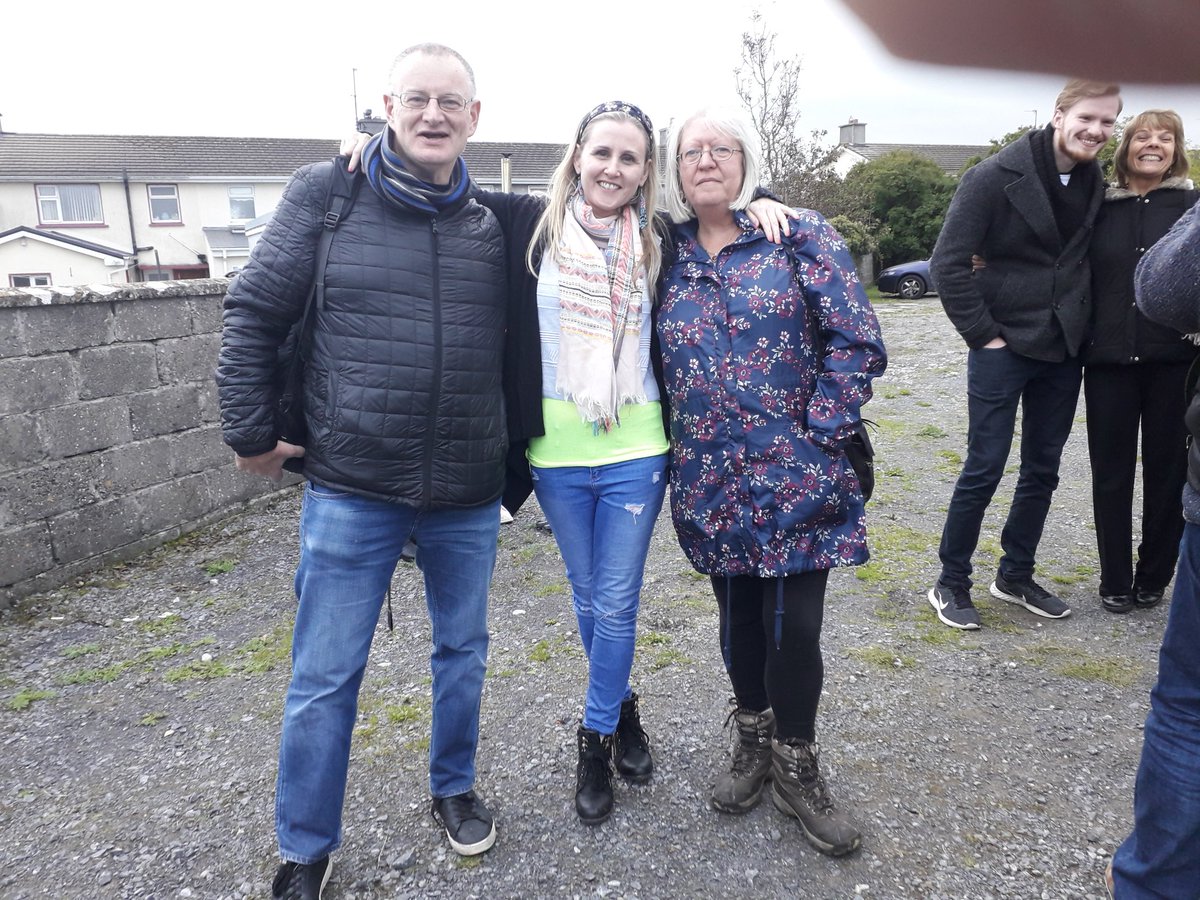 With Alison O'Reilly and Anna Corrigan at the site on Saturday
With Alison O'Reilly and Anna Corrigan at the site on Saturday
At the ceremony, I was also delighted to meet Anna Corrigan of the Tuam Babies Family Group and author Alison O'Reilly
Alison and Anna worked together to write 'My Name is Bridget', the story of Anna's mother who had been incarcerated in the Tuam Mother and Baby Home. Anna, who grew up in Dublin, only discovered that she had two older brothers after her mother passed away. Her two brothers are among the 796 missing children and babies.
The book is a harrowing read, but it also really 'humanises' the story of the lost children and also looks at some other case histories from homes across Ireland.
Breeda Murphy of the Tuam Home Survivors Network pointed out that the infant mortality rate at the home was five times that of the population outside; and that 126 of the babies died within the first six months of life.
“Death certificates were not signed by a medical practitioner, but rather a domestic at the home, burials were outside the norm, custom or law. Without coffins. Without a word, a prayer or a gesture of sympathy in a land that is renowned for its funeral services where communities seek comfort in the untimely death of a young person,” she said.
She pointed out that 35,000 women and girls went through Ireland’s Mother and Baby Home system between 1904 to 1996. This was a national issue, she said, as she pointed out that survivors from institutions all across Ireland had travelled to Tuam for the event.
http://ciarantierney.blogspot.com/2018/10/they-travelled-to-remember-lost.html
(in memory of all women, incarcerated again their will, for no crime, in the Magdalene Laundries in Ireland. And for their children. March 2018) By Elaine Feeney.
the past is built upon the backs of mothers,
on the blood of women who were once girls.
Here under the sun, we lay red tulips
among marble, rock and ash,
the grave is a singing cave for them to echo,
let us remember their labour.
The present is a blinkered face,
as eyes look forward at the day’s business.

Father Brian D'Arcy says the Tuam and Grace scandals should "fill us with disgust and lead us to hang our heads in shame".
16/03/2018 - The outspoken priest asked how Ireland "can establish a pro-life culture if this is how we treated the most vulnerable mothers and babies".
Writing in his column in yesterday's Sunday World, the cleric told readers he visited the Tuam site in recent days to see it for himself.
"It left me shocked, numbed and very angry. The problem was - and still is - I didn't know where to direct my anger.
By Dublin Singer - Songwriter Ciara Sidine
24/02/2018 - I'm just back from a wee tour of Galway and Sligo, playing the intimate setting of The Black Gate Cultural Centre on Thursday and Moy River B&B Folk Club on Friday - with Conor Brady. From the energetic hum of Galway city to the purple-hazed expanse of the Ox Mountains, it was two enjoyable days of music, connection with new audiences and venues, and joy to play with the talent that is Conor Brady. We’re excited for our upcoming tour of Holland, in April.
Porcelain Shoes
By Daniel McConnell (Political Editor - Irish Examiner
08/11/2017 - Six properties promised to the State by the Catholic Church in 2002 still remain outside full public ownership 15 years later, the Irish Examiner can reveal.
Documents obtained reveal a further 13 properties “handed over” in 2009, including the National Rehabilitation Hospital in Dublin, also continue to remain outside of the State’s control.
The Department of Education has been sharply criticised by the chairman and members of the Public Accounts Committee (PAC) for the “unacceptable delays” in transferring the properties over to the State.
By Dan Barry - The New York Times
TUAM, Ireland
Behold a child.
A slight girl all of 6, she leaves the modest family farm, where the father minds the livestock and the mother keeps a painful secret, and walks out to the main road. Off she goes to primary school, off to the Sisters of Mercy.
Her auburn hair in ringlets, this child named Catherine is bound for Tuam, the ancient County Galway town whose name derives from a Latin term for “burial mound.” It is the seat of a Roman Catholic archdiocese, a proud distinction announced by the skyscraping cathedral that for generations has loomed over factory and field.
Two miles into this long-ago Irish morning, the young girl passes through a gantlet of gray formed by high walls along the Dublin Road that seem to thwart sunshine. To her right runs the Parkmore racecourse, where hard-earned shillings are won or lost by a nose. And to her left, the mother and baby home, with glass shards embedded atop its stony enclosure.


